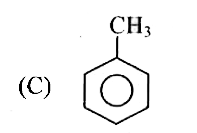Which of the following cycloalkane gives open chain compound, when reacts with bromine
Cyclopropane
Cyclopentane
Cyclohexane
Cyclo-octane
The correct Answer is:A
To solve the question of which cycloalkane gives an open-chain compound when reacting with bromine, we can follow these steps:
Step 1: Understand the Structure of Cycloalkanes
Cycloalkanes are hydrocarbons that contain carbon atoms arranged in a ring. The simplest cycloalkanes are cyclopropane (C3H6), cyclobutane (C4H8), cyclopentane (C5H10), cyclohexane (C6H12), and cyclooctane (C8H16).
Step 2: Analyze the Ring Strain
Among the cycloalkanes listed, cyclopropane has the most significant ring strain due to its three-membered ring structure. This strain arises because the bond angles in cyclopropane are much smaller than the ideal tetrahedral angle of 109.5 degrees, leading to a higher tendency to react and open the ring.
Step 3: Reaction with Bromine
When cyclopropane reacts with bromine (Br2), the high ring strain facilitates the breaking of the ring. The reaction typically involves a free radical mechanism, where the bromine molecule undergoes homolytic cleavage to form bromine radicals. These radicals can then react with the cyclopropane, leading to the opening of the ring and the formation of an open-chain compound.
Step 4: Identify the Correct Answer
Among the options given (cyclopropane, cyclopentane, cyclohexane, and cyclooctane), cyclopropane is the only cycloalkane that readily opens to form an open-chain compound when reacted with bromine due to its significant ring strain.
Conclusion
The correct answer is cyclopropane.
---
Cycloalkanes are hydrocarbons that contain carbon atoms arranged in a ring. The simplest cycloalkanes are cyclopropane (C3H6), cyclobutane (C4H8), cyclopentane (C5H10), cyclohexane (C6H12), and cyclooctane (C8H16).
Among the cycloalkanes listed, cyclopropane has the most significant ring strain due to its three-membered ring structure. This strain arises because the bond angles in cyclopropane are much smaller than the ideal tetrahedral angle of 109.5 degrees, leading to a higher tendency to react and open the ring.
When cyclopropane reacts with bromine (Br2), the high ring strain facilitates the breaking of the ring. The reaction typically involves a free radical mechanism, where the bromine molecule undergoes homolytic cleavage to form bromine radicals. These radicals can then react with the cyclopropane, leading to the opening of the ring and the formation of an open-chain compound.
Among the options given (cyclopropane, cyclopentane, cyclohexane, and cyclooctane), cyclopropane is the only cycloalkane that readily opens to form an open-chain compound when reacted with bromine due to its significant ring strain.
The correct answer is cyclopropane.
Topper's Solved these Questions
- BOOK - ERRORLESS CHAPTER - HYDROCARBONEXERCISE - ORDINARY THINKING (Objective question) (ALKENE)129videos
HYDROCARBON
- BOOK - ERRORLESS CHAPTER - HYDROCARBONEXERCISE - ORDINARY THINKING (Objective question) (ALKYNE)120videos
HYDROCARBON
- BOOK - ERRORLESS CHAPTER - HALOGEN CONTAINING COMPOUNDEXERCISE - Critical Thinking (Jee (Advanced) 2018)1videos
HALOGEN CONTAINING COMPOUND
- BOOK - ERRORLESS CHAPTER - IONIC EQUILIBRIUMEXERCISE - JS Jee Section (JEE Advanced (Numeric answer type question))1videos
IONIC EQUILIBRIUM
Similar Questions
Knowledge Check
- Question 1 - Select One
which of the following is a cycloalkane ?
A B
B C
C D
D
- Question 2 - Select One or More
Which of the following gives an optically active compound when reacted with sodium borohydride NaBH4?
A B
B C
C D
D
- Question 3 - Select One
Which of the following compound would give secondary alcohol when reacts with an excess of phenyl magnisium bromide followed by hydrolysis.
A B
B C
C DC6H5−CH3CN
DC6H5−CH3CN
Which of the following substance will give amide, when it reacts with NH3 ?
View SolutionWhich of the following compound gives yellow oily liquid nitrosamine when react with nitrous aicd
View SolutionWhich of the following compound does not give yellow ppt. when react with NaOI ?
View SolutionWhich of the following compound gives a product with foul smell when reacted with chloroform in presence of a alkali ?
View SolutionWhich of the following would give benzene when reacted with PhMgBr ?
View Solution

